Many older houses in Minneapolis and Saint Paul have an old style of plumbing trap called a drum trap, which is no longer allowed in Minnesota except in special circumstances. If you’re buying a home that has one or you already own a home with a drum trap, here’s what you ought to know about them. And for those who prefer to listen and watch, here’s a video:
Drum traps come in different shapes, sizes, and configurations. The crude diagrams below show a few examples of different types of drum traps I’ve come across, as well as one type of setup that wouldn’t create a water seal trap, shown at the bottom right.
As I’ve mentioned in previous posts, you need plumbing traps to prevent sewer gas from entering your home. Drum traps do the same thing, but instead of just having a dip in the pipe to create a self-scouring P-trap, a drum trap consists of an enlarged ‘vessel’ that holds a large volume of water. Drum traps were commonly used at bathtubs and occasionally at laundry sinks at older Minnesota homes. I’ve seen a few drum traps at kitchen sinks too, but never at a bathroom sink.
Why they used to be popular
I explained how plumbing vents prevent water from getting siphoned out of traps and why it matters in my posts about s-traps and plumbing vents. Water can be siphoned out of a drum trap in the same way it can be siphoned out of a p-trap or s-trap, but drum traps hold so much water that it’s pretty much impossible to have enough water siphon out to allow sewer gas into the home.
Drum traps were also supposed to be easier to open up for cleaning and retrieving lost items, but it didn’t always work that way. I’ll come back to this.
Why they’re no longer allowed, for the most part
One of the basic plumbing principals of the Minnesota State Plumbing Code (4715.0200, “s”) says that “Each fixture shall be provided with a separate, accessible, self-scouring, reliable trap placed as near to the fixture as possible.” If you take apart any properly installed p-trap, you’ll probably find that it’s nice and clean inside; this is because it’s self-scouring. Water drains through the trap so fast that any solid materials are pulled out of the trap along with the water. Can you imagine sand or anything similar getting stuck at the bottom of this trap?
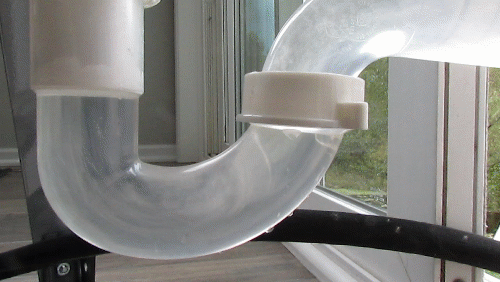
No way.
With a drum trap, on the other hand, you get no such cleaning action. A drum trap holds so much water that any solids entering the trap won’t be pulled directly through, which can allow for solids to accumulate in the bottom of the trap. This makes drum traps more prone to getting clogged.
Couple that with some goofy, old designs, and you can end up with some very slow-draining traps.
Another problem with drum traps is that they can be difficult to clean. Most drum traps have a removable cover, but drum traps are usually located right below the floor, making the lid extremely difficult to access without cutting out the floor. Some drum traps are installed with the cleanout cover installed upside-down, some don’t have room to remove the cover, and some are installed on their sides. Those have to be especially fun to clean out ;-).
Even when the cover is accessible, it can be difficult or impossible to remove the cover because the threads are rusted shut, or if the drum trap is made from lead, which is a very soft material. I’ve seen lead drum traps collapsed in on themselves from people cranking on them. This leads to makeshift repairs.
When the cover for a drum trap is accessible and easy to remove, it’s important to make sure that it makes a tight seal. It has the potential to allow sewer gas into the home or leak if not sealed properly.
What to do about them
If you have an old drum trap in your house or you’re buying an old house with a drum trap, there’s no need to get whipped up. Drum traps usually work just fine, but they’re more prone to getting clogged and can be difficult to service. Wait until a plumber is out doing other work to have your drum trap replaced.
If you have a nasty odor in a bathroom that you can’t get to the bottom of, check to see if you have a drum trap. Because solids remain in drum traps, they can turn into stinky, miniature cesspools. I recently helped a friend get to the bottom of a stinky bathroom issue by finding a drum trap for the bathtub. When I filled the sink up with water and then drained it, water backed out of the bathtub and made an odor bad enough to make my eyes water. Replacing the drain would be an expensive option, but thoroughly cleaning the drain might be enough to prevent future odors.
On a personal note, I had a drum trap at my old home in Minneapolis. It clogged shortly after I moved in, so I removed the cover and cleaned it out. I put the cover back on, and never had a problem with it for the next seven years that I lived there. It was installed in such a way that replacing it would have required making a nasty hole in one of my floor joists, so I left it alone.
*The exception
Section 1004.1 of the Minnesota State Plumbing Code says “Drum and bottle traps shall be installed for special conditions.” I don’t know what those special conditions are, but if I look at the old Minnesota plumbing code, I could guess. Our old code said “Drum traps shall be installed only when permitted by the administrative authority for special conditions (laboratory tables, dental chairs, etc.).” Drum traps are used in these locations because they’re not self-scouring. If someone’s gold filling falls down the drain, a drum trap will allow it to just sit in the bottom for retrieval.
A few photos, just for fun
The drum trap shown below leaked profusely when we filled the bathtub with water and then drained it.
Here’s a drum trap at a laundry sink.
The drum trap at this next laundry sink had a severely corroded cap.
Here’s a lead trap with the cleanout facing down. This drain has clearly lost the battle with gravity; note where the notch in the floor joist is located.
Here’s a nice mix of galvanized steel, cast iron, ABS, and PVC drain lines, all leading to a drum trap on the left side.
Here’s a radiator hose bent into the shape of a trap, which drains into a ‘drum trap’ that’s not really a trap at all, because it’s draining through the bottom directly to the sewer.
These next three show one of the only drum traps I’ve found at a kitchen-type sink. I say ‘kitchen-type’ sink because this sink was actually in the butler’s pantry of a home built in 1900.
And finally, here’s one of my favorite photos of all time. This drum trap had probably rusted apart or someone had to cut the bottom off to clean it out, so MacGyver fixed it with the bottom of a coffee can, glue, tape, and string. Spray-painting the bottom red was also a nice touch.

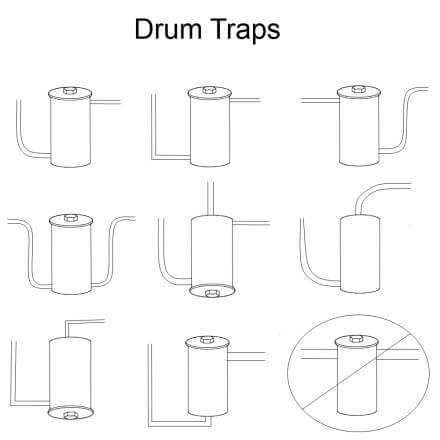
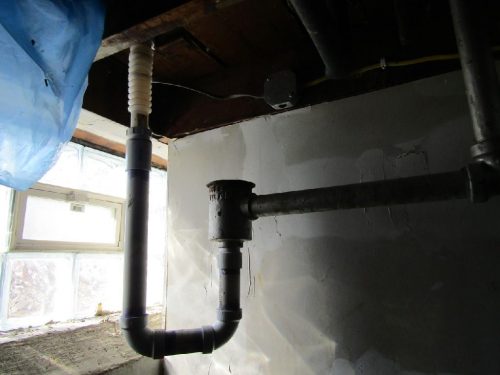
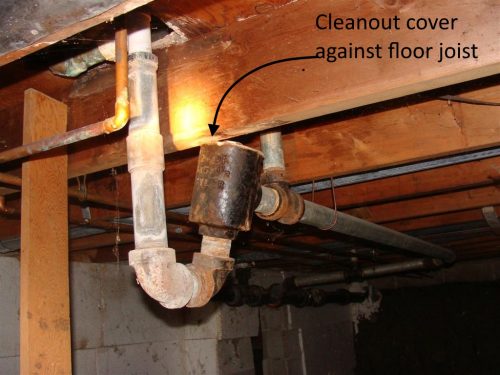
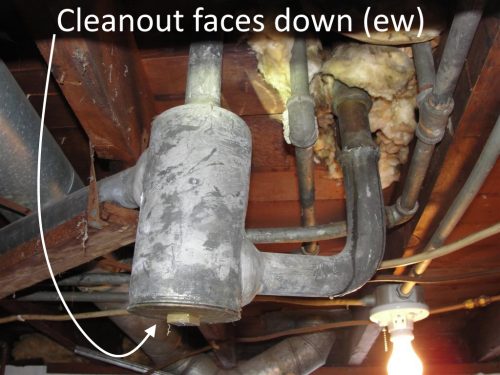
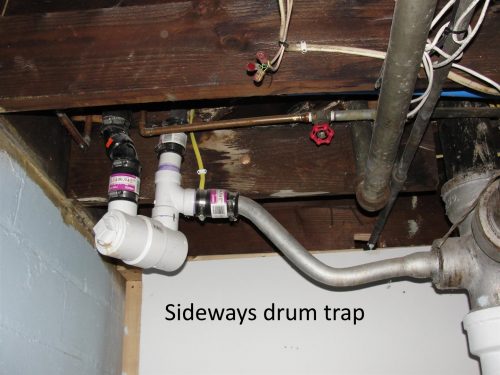
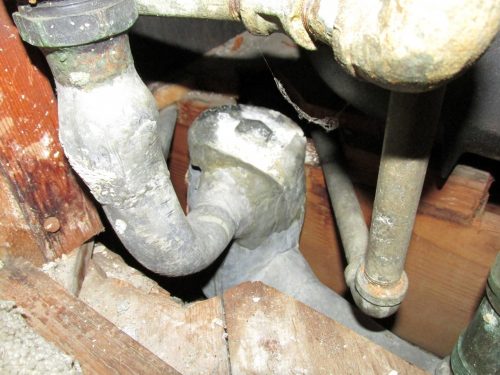
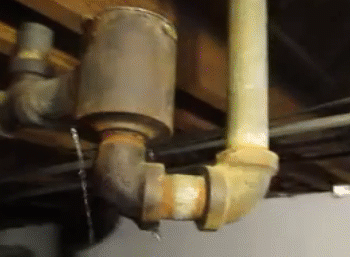
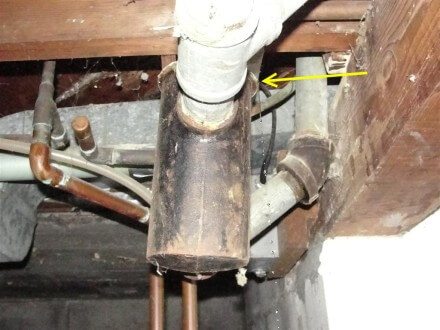
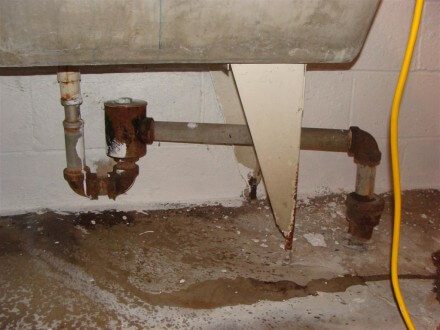
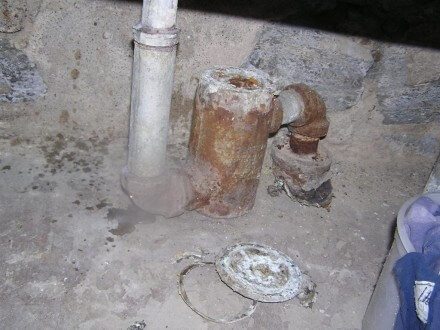
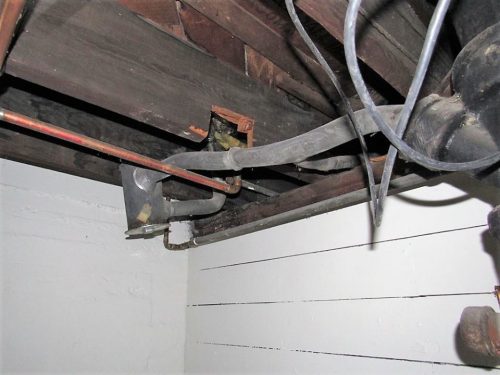
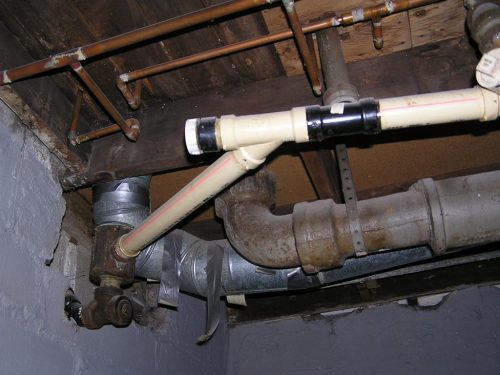
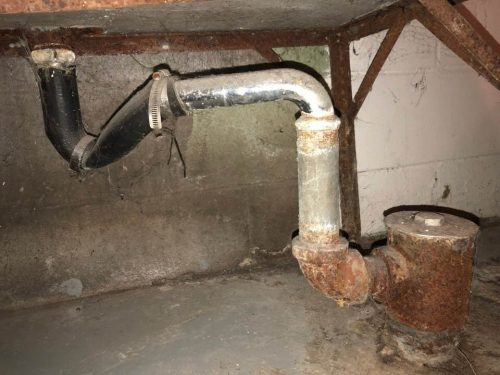
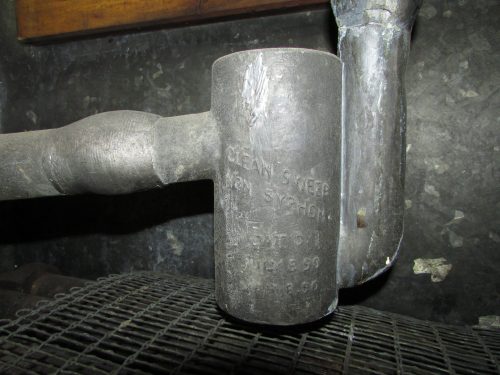
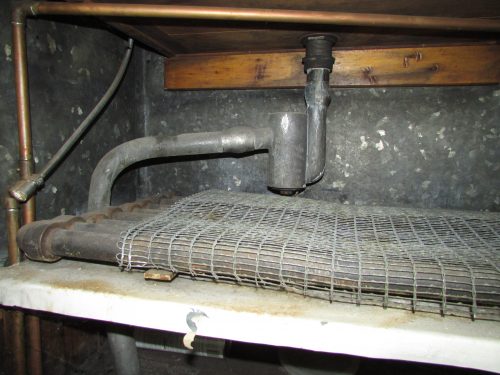
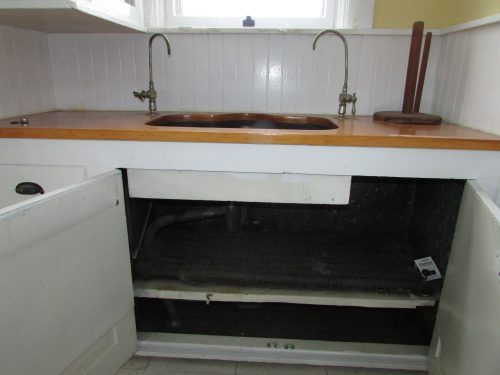
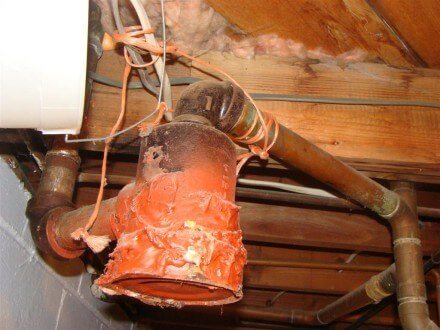

James
August 3, 2019, 6:38 am
Amazing blog. This is quite informative.
BRENDA R
September 15, 2019, 9:04 am
HI, DRUM TRAP BELOW TUB IN BASEMENT THAT GOES TO SEWER PIPE THE CROME COVER HAS A PIN WHOLE IN IT AND IS DRIPPING, I DID FIND A NEW ONE, BUT HAVING A HARD TIME TRYING TO REMOVE THE OLD ONE, ANY SUGESTIONS?? TURN RIGHT OR LEFT? OT TRY TO PUT A BIGGER HOLE IN IT TO DRAIN WATER OUT FIRST? TO RELIEVE ANY PRESSURE?? HELP.
Brenda R.
Reuben Saltzman
September 16, 2019, 4:41 am
Hi Brenda, turn the cap counter-clockwise. There shouldn’t be any pressure in there, so adding a hole won’t help. I know of someone who once had to take a saw and cut the top off, then rig a funky cap onto the top. This was a very temporary solution until a plumber could replace the entire assembly. That would probably be your best option.
Emily
October 3, 2019, 3:04 pm
I recently bought a 100 yr old home. Im doing some remodeling and i wanna keep as much of it as I can in its original state. I have old cast iron piping and my guest bathroom tub will not go down I think it is probably the trap but I know it’s gonna be impossible to unscrew and clean it out it probably has never been opened what should I do
Reuben Saltzman
October 4, 2019, 4:22 am
Hi Emily,
Your problem is surely all of that cast iron. You really ought to hire a plumber to pull all of that out and replace it. I know that’s not what you want to hear, and it’ll be expensive, but that’s the right thing to do.
If you’re determined to get inside of your drum trap, go to the store and pick up a rubber test cap that approximately fits your drum trap, or possibly a test plug. Google “Fernco test cap” to see what I’m talking about. Next, cut off the top of your drum treap with a reciprocating saw (aka – Sawzall). You’re in. Now keep your fingers crossed and hope that you can cap or plug the drum trap and make it completely tight.
Best of luck!
Robert G.
July 24, 2021, 10:52 am
I just wanted to say thanks, It’s because of people like you informing people like us that we feel informed enough to weigh our options and conquer the world if we so choose. “Well Done” !!!